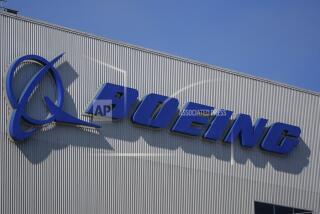Damage control
- Share via
HOURS BEFORE THE START of an ill-advised strike last Friday against Northwest Airlines, a leader of the airline’s mechanics’ union stood before a gathering of fellow members and offered some advice. “Enjoy this,” he said. “This is a chance in a lifetime to screw Northwest.”
Motivations aside -- and the remark, reported in the Detroit Free Press, betrays a pretty thin rationale for calling a strike -- it’s not turning out that way. So far, the airline is flying far higher than the 4,400 striking mechanics and custodians.
Following the Saturday morning walkout, Northwest unveiled a contingency plan that cost $107 million to create and took 18 months to plan. It filled the mechanics’ jobs with about 1,900 nonunion replacement workers, most of whom already had been furloughed by other airlines, and outsourced most of its major aircraft maintenance to contractors, emulating a business model used by such carriers as JetBlue and Southwest Airlines to keep labor costs down.
Much to the chagrin of the Aircraft Mechanics Fraternal Assn., which represents Northwest’s mechanics and custodians, the plan is working. Aside from a few glitches, replacement mechanics boosted the airline’s on-time rate to nearly 70% Wednesday from 46% Saturday, according to JoeSentMe.com, a website monitoring Northwest flights during the strike. It’s a lackluster performance, and certainly not one that will please Northwest’s customers. But it’s still far from crippling the nation’s fourth-largest airline.
Much of the reason Northwest is still flying is that AMFA, considered a renegade union outside the larger AFL-CIO umbrella, isn’t garnering much sympathy from other unions. Pilots and flight attendants have dutifully crossed picket lines at the airline’s hubs. Unionized ground workers are even cleaning Northwest’s passenger cabins between flights, a job usually performed by AMFA-represented custodians.
At this point, the union’s best hope is to return to the bargaining table immediately. Northwest, which lost $225 million last quarter, says it needs to cut about $1.1 billion in labor costs to avert bankruptcy. The airline had proposed laying off 2,000 AMFA workers and slashing the pay of the rest by about 25%. Northwest’s mechanics earn an average annual salary of about $70,000, which is the second highest in the industry.
The proposed cuts undoubtedly would be painful. But the boom years of the late 1990s, when airlines agreed to lucrative labor contracts, are over. Passenger levels are up around pre-9/11 levels, but competition with low-fare carriers and record-high fuel prices have kept legacy carriers uncomfortably in the red.
Northwest is evaluating whether it will hire some replacement workers permanently. Such a move could deal a fatal blow not just to the mechanics but to the clout of unions in the industry as a whole. It was just 14 years ago that a nearly two-year machinists’ strike forced then-ailing Eastern Airlines, once a powerhouse in the airline industry, to stop flying for good. Few would argue that such an outcome is even a remote possibility in the current circumstances.
There is little doubt that the American labor movement, which claims a minuscule 12% of the workforce (down from more than 30% in the 1950s), is in crisis. And while political dissension wracks the AFL-CIO, labor’s troubles are especially evident in the airline industry, where it was once so powerful. If Northwest’s $107-million contingency plan becomes permanent -- and there’s a good chance it will -- other airlines, and other industries, will take notice.
More to Read
Inside the business of entertainment
The Wide Shot brings you news, analysis and insights on everything from streaming wars to production — and what it all means for the future.
You may occasionally receive promotional content from the Los Angeles Times.










